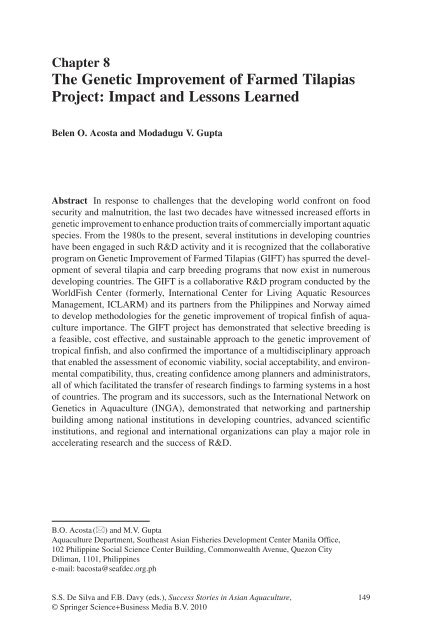Success Stories In Asian Aquaculture - Library - Network of ...
Success Stories In Asian Aquaculture - Library - Network of ...
Success Stories In Asian Aquaculture - Library - Network of ...
- No tags were found...
You also want an ePaper? Increase the reach of your titles
YUMPU automatically turns print PDFs into web optimized ePapers that Google loves.
Chapter 8The Genetic Improvement <strong>of</strong> Farmed TilapiasProject: Impact and Lessons LearnedBelen O. Acosta and Modadugu V. GuptaAbstract <strong>In</strong> response to challenges that the developing world confront on foodsecurity and malnutrition, the last two decades have witnessed increased efforts ingenetic improvement to enhance production traits <strong>of</strong> commercially important aquaticspecies. From the 1980s to the present, several institutions in developing countrieshave been engaged in such R&D activity and it is recognized that the collaborativeprogram on Genetic Improvement <strong>of</strong> Farmed Tilapias (GIFT) has spurred the development<strong>of</strong> several tilapia and carp breeding programs that now exist in numerousdeveloping countries. The GIFT is a collaborative R&D program conducted by theWorldFish Center (formerly, <strong>In</strong>ternational Center for Living Aquatic ResourcesManagement, ICLARM) and its partners from the Philippines and Norway aimedto develop methodologies for the genetic improvement <strong>of</strong> tropical finfish <strong>of</strong> aquacultureimportance. The GIFT project has demonstrated that selective breeding isa feasible, cost effective, and sustainable approach to the genetic improvement <strong>of</strong>tropical finfish, and also confirmed the importance <strong>of</strong> a multidisciplinary approachthat enabled the assessment <strong>of</strong> economic viability, social acceptability, and environmentalcompatibility, thus, creating confidence among planners and administrators,all <strong>of</strong> which facilitated the transfer <strong>of</strong> research findings to farming systems in a host<strong>of</strong> countries. The program and its successors, such as the <strong>In</strong>ternational <strong>Network</strong> onGenetics in <strong>Aquaculture</strong> (INGA), demonstrated that networking and partnershipbuilding among national institutions in developing countries, advanced scientificinstitutions, and regional and international organizations can play a major role inaccelerating research and the success <strong>of</strong> R&D.B.O. Acosta () and M.V. Gupta<strong>Aquaculture</strong> Department, Southeast <strong>Asian</strong> Fisheries Development Center Manila Office,102 Philippine Social Science Center Building, Commonwealth Avenue , Quezon CityDiliman , 1101 , Philippinese-mail: bacosta@seafdec.org.phS.S. De Silva and F.B. Davy (eds.), <strong>Success</strong> <strong>Stories</strong> in <strong>Asian</strong> <strong>Aquaculture</strong>,© Springer Science+Business Media B.V. 2010149
















